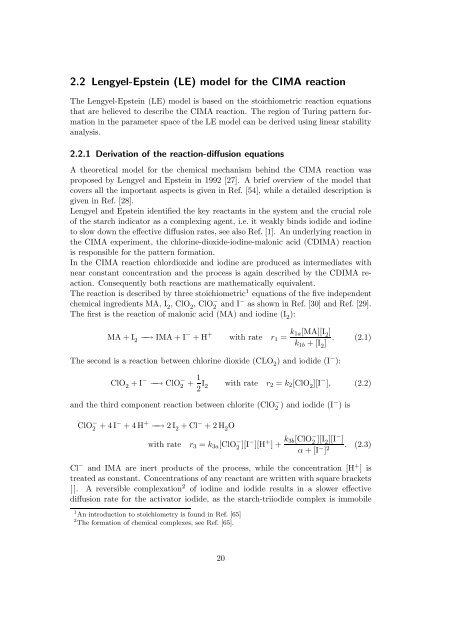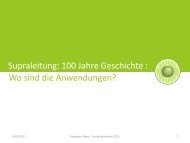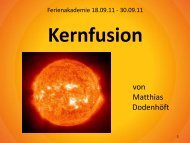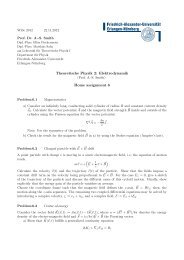Morphology of Experimental and Simulated Turing Patterns
Morphology of Experimental and Simulated Turing Patterns
Morphology of Experimental and Simulated Turing Patterns
You also want an ePaper? Increase the reach of your titles
YUMPU automatically turns print PDFs into web optimized ePapers that Google loves.
2.2 Lengyel-Epstein (LE) model for the CIMA reactionThe Lengyel-Epstein (LE) model is based on the stoichiometric reaction equationsthat are believed to describe the CIMA reaction. The region <strong>of</strong> <strong>Turing</strong> pattern formationin the parameter space <strong>of</strong> the LE model can be derived using linear stabilityanalysis.2.2.1 Derivation <strong>of</strong> the reaction-diffusion equationsA theoretical model for the chemical mechanism behind the CIMA reaction wasproposed by Lengyel <strong>and</strong> Epstein in 1992 [27]. A brief overview <strong>of</strong> the model thatcovers all the important aspects is given in Ref. [54], while a detailed description isgiven in Ref. [28].Lengyel <strong>and</strong> Epstein identified the key reactants in the system <strong>and</strong> the crucial role<strong>of</strong> the starch indicator as a complexing agent, i.e. it weakly binds iodide <strong>and</strong> iodineto slow down the effective diffusion rates, see also Ref. [1]. An underlying reaction inthe CIMA experiment, the chlorine-dioxide-iodine-malonic acid (CDIMA) reactionis responsible for the pattern formation.In the CIMA reaction chlordioxide <strong>and</strong> iodine are produced as intermediates withnear constant concentration <strong>and</strong> the process is again described by the CDIMA reaction.Consequently both reactions are mathematically equivalent.The reaction is described by three stoichiometric 1 equations <strong>of</strong> the five independentchemical ingredients MA, I 2, ClO 2, ClO − 2 <strong>and</strong> I− as shown in Ref. [30] <strong>and</strong> Ref. [29].The first is the reaction <strong>of</strong> malonic acid (MA) <strong>and</strong> iodine (I 2 ):MA + I 2 −→ IMA + I − + H + with rate r 1 = k 1a[MA][I 2 ]. (2.1)k 1b + [I 2 ]The second is a reaction between chlorine dioxide (CLO 2 ) <strong>and</strong> iodide (I − ):ClO 2 + I − −→ ClO − 2 + 1 2 I 2 with rate r 2 = k 2 [ClO 2 ][I − ], (2.2)<strong>and</strong> the third component reaction between chlorite (ClO − 2 ) <strong>and</strong> iodide (I− ) isClO − 2 + 4I− + 4 H + −→ 2 I 2 + Cl − + 2 H 2 Owith rate r 3 = k 3a [ClO − 2 ][I− ][H + ] + k 3b[ClO − 2 ][I 2 ][I− ]α + [I − ] 2 . (2.3)Cl − <strong>and</strong> IMA are inert products <strong>of</strong> the process, while the concentration [H + ] istreated as constant. Concentrations <strong>of</strong> any reactant are written with square brackets[]. A reversible complexation 2 <strong>of</strong> iodine <strong>and</strong> iodide results in a slower effectivediffusion rate for the activator iodide, as the starch-triiodide complex is immobile1 An introduction to stoichiometry is found in Ref. [65]2 The formation <strong>of</strong> chemical complexes, see Ref. [65].20






